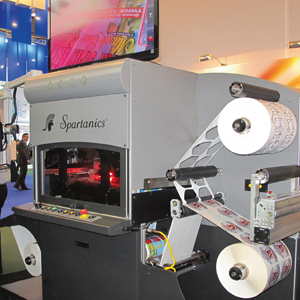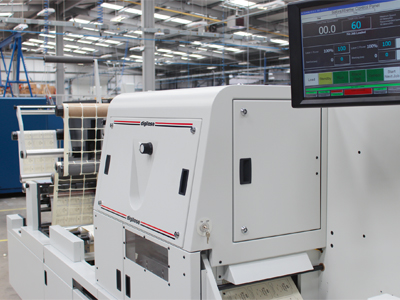ABG Digilase cutting unit
So which is the odd one out? Metal, concrete, wood, stone, paper, polyester, board or James Bond? Answer: Bond, as all the others can be cut and finished with a laser! Despite the worst intentions of Mr Goldfinger, 007 is immune from the laser – even if the table he is tied to fares less well. Sean Smyth looks at lasers in finishing (though not directly at the light).
Increasingly more label and packaging converters are using digital laser cutting technology, and there are more suppliers pushing their solutions. At Labelexpo last September there were 18 suppliers of laser finishing systems – actually many more systems, with some incorporated into many finishing lines. Spartanics had systems on four stands as well as its own, namely Durst, INX, SMAG and in the Smart Packaging Lab.
Set to stun
Laser cutting employs high powered solid state, or CO2 lasers, to vaporise material in the beam path. Spot size can be altered and the power can be adjusted to fully cut, kiss-cut or just score the substrate that could be paper, film or board. There is no mechanical cutting die, the shape is defined digitally and this drives the laser for a particular job. Improvements in the technology means there is little burning and discolouration with the latest systems, and the laser can be set to mark the stock to add security features or coding.
Most laser cutters are galvanometer systems that have one or more fixed laser source that are focused onto rotating mirrors to write the desired patterns, either continuously or as a set of rapid pulses. The laser power will be tuned to a particular stock, with variable cutting depth set as part of the calibration, and extremely accurate results are possible, including more intricate patterns than possible with mechanical die-cutting. Speed and throughput depends on the laser power and complexity of the design, a longer cutting path takes more time than a simple square or ellipse to cut.
On the edge
The suppliers stress the benefits of eliminating tools and reduced set-up costs, with savings in changeover time and waste, advantages that are well proven for many stocks. After the initial learning curve, systems are flexible and easy to use. Slightly more contentious are claims of improved precision and edge cut quality, however.
Spartanics is a US company located near Chicago which is a laser pioneer and claims to provide the fastest single source laser cutters with web speeds in excess of 100 m/min, for any geometry without burn through marks, discolouration or pinholes. Digital converter ImageTek Labels of Springfield, in Vermont, installed its first Spartanics semi-rotary laser die-cutting system in 2015. ‘We pride ourselves on providing our customers with the best quality labels for their most demanding needs,’ explained Bethaney Lanou, technical sales and procurement specialist at ImageTek. ‘This unit will allow us to expand our capabilities utilising a wider format, laser cutting, hot stamping, laminating and sheeting all in one pass. We are very excited to offer these new capabilities to our customers – it’s a game changer for sure.’
The offline system comprises a hot stamping system, a dual sided laminator, a 400 Watt high speed laser die-cutting station with a 350 mm working field, a combination semi or full rotary die-cutting station, a varnish flexo station, coil parts extraction unit, a rotary sheeter, driven by the Spartanics Fastline Laser Cutting Software. This unit can operate as a roll to roll or roll to sheet system.
AB Graphic International has been developing laser technology for 15 years. At last year’s Labelexpo it showcased the Digilase (personally I preferred the old Sabre Xtreme name), changing jobs on the fly. ‘We are seeing a lot of interest in our laser module, and particularly when it’s combined with other Digicon Series 3 high specification finishing modules, it offers more than any other laser in the market. Various shaped through-cut holes can easily be removed from the web with our bit and slug removal system’, said Tony Bell, sales director for ABG.
As well as the cutting units, ABG has worked to improve the set up and control software, with emphasis on pre-press and workflow developments. Laser files are created from open standard SVG files, with no need to manipulate the artwork to create the die line. The laser is JDF compatible, working in conjunction with an MIS system, making it straightforward to step and repeat a die line or adjust and create material files, allowing great flexibility. In operation the laser cutter becomes a key part in providing a link between pre-press/MIS and the machine’s workflow. This means it can share some of the parameterisation of automated modules.
One of ABG’s new laser finishing customers, Imprimerie de L’Eperon, in the southwest of France, is not new to lasers. ‘We have been involved in laser (non-ABG) and digital printing since 2004 and have dealt with ABG for eight years on other finishing equipment. After we made the decision to update our digital finishing equipment and specifically our laser line, we made an in-depth study of the market place. After using laser technology for over a decade we decided to invest for our future in ABG’s Digilase,’ said Christophe Vavassori, president.
In combination
Italian company SEI Laser is based in Curno near Bergamo to the north of Milan where it makes laser cutting systems for the automotive, metal fabrication, lighting, converting, packaging, fashion, electronics and visual communication sectors. SEI supplies equipment both directly and as an OEM for various systems including the EFI Jetrion 4950LX. The Labelmaster can be equipped with one to four laser heads, to maximise productivity to finish paper, PET, PP and BOPP.
GM is selling the DC330 hybrid system, which combines mechanical and digital cutting, and incorporates various finishing modules. It also supplies a compact laser only system for labels, aimed at short runs. CS Labels in Willenhall is a user, buying a GM L330 in June to speed up the label finishing. Managing director Simon Smith commented, ‘Set-up times are extremely fast and the machine can also properly cut peel and reveal labels which are traditionally difficult to cut with a laser.’ The CO2 laser was upgraded to 200 mW at the end of October to speed throughput and increase efficiency. The laser also re-melts toner at the edge of a label, sealing it in position and eliminating cracking and flaking that sometimes happens with mechanical cutting on Xeikon print.

Spartanics unit running at Labelexpo
Italian supplier Cartes has some 200 laser label finishing systems in operation in 42 countries, with the first install back in 2001. The laser converter is usually combined with other finishing modules. Cartes is promoting ILC – Invisible Laser Cutting – which makes it possible to die-cut heavy coverage printed labels avoiding any white edge effect. How it does this is not clear, possibly adjusting the temperature downward, as Cartes also claims it prevents adhesive from melting and flowing under the cut edge of labels where it causes jams and sticking at application. With ILC there will be fewer restrictions in processing materials with extremely thin liners (a few microns thick) including films, or linerless materials like IML labels.
Beyond labels
There are low cost suppliers offering entry level systems. As laser applications grow, there are desktop laser cutters and engravers on the market, and several suppliers are offering modified systems to finish labels. Examples include the Korean manufacturer Bitek Technology’s Anytron laser die-cutter, while Colordyne has partnered with LasX for a range of laser cutters.
LasX also focuses on short run cartons, with scoring, perforation and cutting offered. This is one example of laser cutting being used beyond labels, there is adoption also in flexible packaging.
In cartons Highcon is notching up successes. It reported a very productive 2015, with new installs of the Euclid II made in North America, Europe, Asia and Africa, including three repeat orders by existing customers. Laser cutting is growing in many other print applications. Chinese litho press manufacturer Hans Grohni is selling two models, the LC340 and LC660, while Motion Cutter is making waves in commercial print. It is labels and packaging that lead the way.
Laser finishing is not a panacea. It is not suitable for all materials and applications, but the use is growing as the technology improves and converters gain more experience. It can certainly provide greater consistency and flexibility, two critical factors as run lengths continue to fall and new products come to market. But laser finishing is not just an alternative to mechanical cutting, it is a digital finishing system and can be incorporated into fully automated workflows when combined in-line with a digital press. Converters can thus maximise flexibility by eliminating the need for physical tools that can be costly and take time to produce.
There will be a growing trend for small quantities to be specified and ordered on line, with artwork uploaded by the customer into a range of custom and bespoke shapes. Web to label is a sector that is poised to grow; it requires the steps of design, order placement, artwork, printing, finishing, shipment and invoicing to be handled by the system with no manual intervention. Laser finishing is an enabler for this sector.








